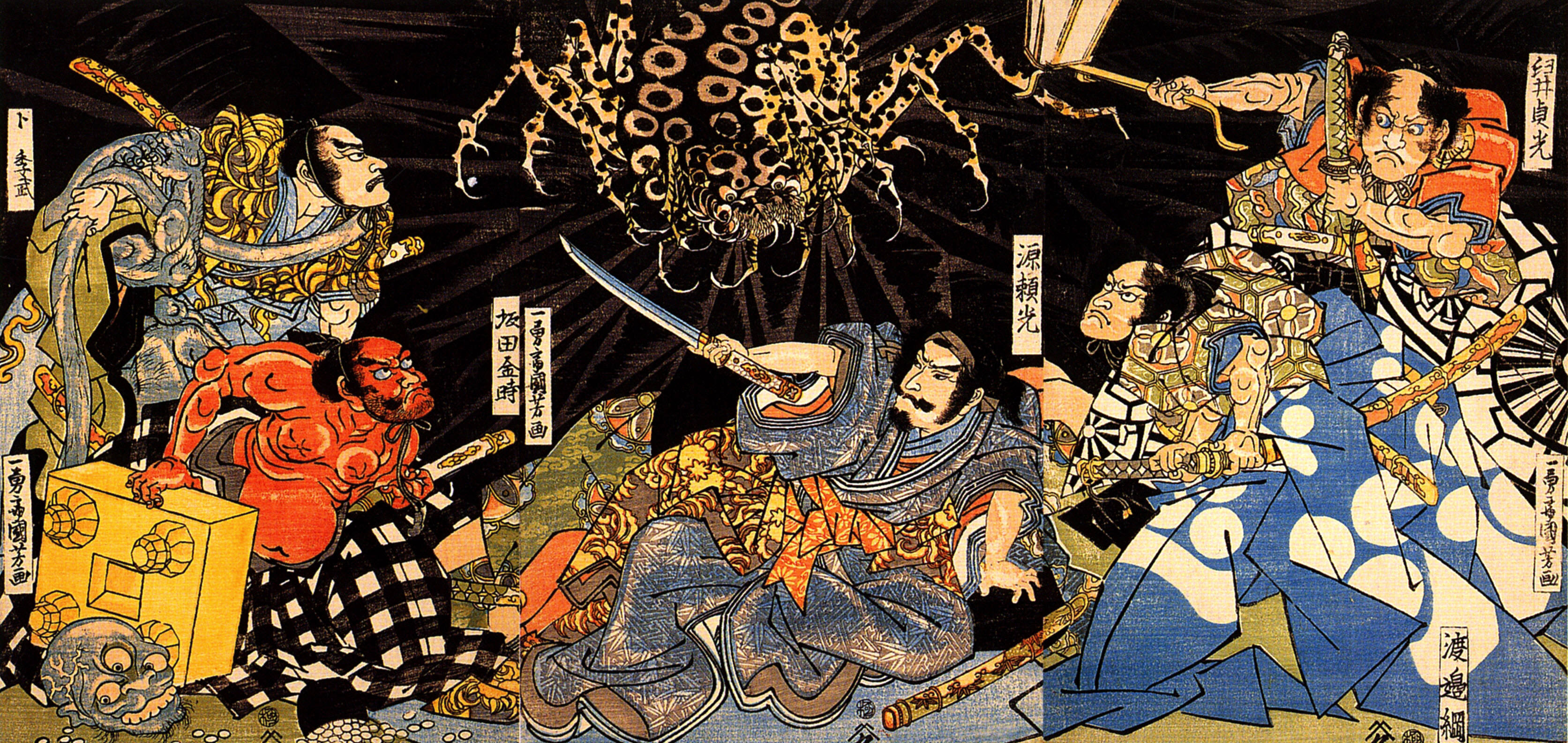Content warning: spidey bois.
Let me take you back to somewhere around the year 1000 in Classical Japan. Minamoto no Raikō, legendary commander and warrior, lies suffering from a fever, preparing to die. Noh theatre performances still capture the moment to this day. From Raikō (in translation):
“Oh, life is so fragile. Looking back, it is like a bubble that disappears here and appears there. I float and reincarnate in this world. No one can understand my serious illness, just as heavy as this duvet. There is no one to be blamed for this illness, so I can hold no grudge over it. I have to remain in bed by myself and continue to agonize even while resting.”
Various cures are tried, but nothing seems to help. Then, in the dead of night, a Buddhist monk appears abruptly at Raikō’s door.
“Though it is a beautiful night with the clear moon, misty clouds suddenly rise in the middle of the night and hide the moon.”
According to legend, the monk is strange-looking and large, almost 7 feet tall. Taken aback, still feverish, Raikō demands to know who he is and what he’s doing there. In response, the monk berates him, and quotes an old poem:
“My husband will come tonight as the spider’s behavior tells me so…”
It’s the only clue Raikō needs.
“Did you say the spider’s behavior? I see. I did not identify you and now understand that your behavior is like that of a spider, which rudely approaches me.”
The monk acts fast, throwing out his hands and shooting out thousands of strands of web. Raikō would be captured and doomed, if it were not for the sword he has hidden under his pillow. He slashes at the monk, and the monster disappears, leaving puddles of blood in his wake.
Familiar foes
From here, the Noh play and the legends diverge a bit, though the core arc of the story remains. Either Raikō or his retainers follow the trail of blood to a cave deep in the mountains, where they find, to their horror, tunnels made of spider silk big enough for a man to walk through. Deep in these tunnels lies the tsuchigumo, the enormous arachnid yōkai, with the face of an oni (demon) and the body of a tiger.

A battle ensues. The tsuchigumo offers a fearsome fight, trying to ensare its attackers with silk. When its its abdomen is finally split, an explosion of human skulls (1,990, according to one tale) precipitates thousands of baby spiders. These scurry at the humans and up the cave walls, and the warriors must kill every last one before they can finally declare victory. Once they do, Raikō’s mysterious illness is cured, and everything is well again.
But this will not be the last time (and is maybe not the first) that Raikō faces down the hideous spider. The showdowns happen again and again with similar scripts, but different details. In one version, Raikō’s servant boy turns out to be secretly poisoning him. When Raikō cuts him open, the illusion breaks, and he finds that the boy has covered him in spiderwebs. They follow the boy’s trail of blood and discover a tsuchigumo, dead from the wound Raikō inflicted. In another version, Raikō and his retainers face down an entire yōkai army, headed by a beautiful and mysterious woman. Suspecting trickery, Raikō targets the woman, and when he cuts her the army vanishes and she flees into the mountains. They hunt her down to a cave, where she morphs into a giant spider, rearing back and ready to fight Raikō in her true form.

Hairy inspiration
So where did the tsuchigumo stories come from? There are no native tarantula species to Japan, though there are plenty of other frightening-looking spiders, and neighboring China and Vietnam have some bad boys that look like this:

…which might have provided some inspiration. These tarantulas do burrow in the ground with silk tunnels like the ones described in the stories. And “tsuchigumo” does translate roughly to “ground spider.”
It’s not a big leap for any anyone to look at one of those and go “hey, that’s heinous. Sure glad it’s not car-sized, amirite?” Humans have done just that all around the world. Giant spider monsters are, after all, not unique to Japan, nor are tsuchigumo even the only spider yōkai.
Tangled web of history
But the name “tsuchigumo” happens to have some historical context that casts these stories in a new light. It turns out that back in the day, “tsuchigumo” was used less to describe a literal tarantula monster and more as a derogatory term for the indigenous, earthen-mound-dwelling rebels who dared to fight back against the power of the Yamato court.

One can see evidence of this still even in that Noh play I quoted above. When getting ready for the final tsuchigumo standoff, one warrior comments: “Even a handful of soil and a branch of tree in this land belong to the Emperor [emphasis mine]. So, there is no room for a demon to live.” When you look into the history, a lot of the pieces start to make sense. Those that fought against royalty had to resort to underhand tactics such as guerilla warfare, just as tsuchigumo resort to trickery in order to try to best the military might of Raikō and his ilk.
Of course, that hardly makes the tsuchigumo less affecting. It’s said that some human tsuchigumo were cut up and buried in separate pieces at Mount Yamato Katsuagi shrine to prevent their grudges from coming back and harming the living. To me, this sounds like precisely the recipe to encourage grudges to come back and harm the living.
So which is worse: vengeful ghosts or spiders with fangs the size of your arm? Some dilemmas are too dark for even a monster blog to decide.
Would a tarantula look better or worse with frosted tips? Share your opinions in the comments below.
IMAGE CRED: Tokyo National Museum for the OG; Utagawa Kuniyoshi for the leopard-y guy; Chris A. Hamilton, Brent E. Hendrixson, and Jason E. Bond for the very detailed tarantula; Brigham Young University for the 3-eyed guy. Eva Wilcock for the featured image.





0 Comments